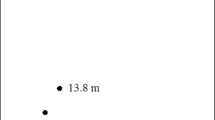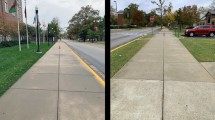Abstract
The perceived distance of a sound source in a room has been shown to depend on the ratio of the energies of direct and reflected sound1. Although this relationship was verified in later studies2,3,4, the research has never led to a quantitative model. The advent of techniques for the generation of virtual sound sources5,6 has made it possible to study distance perception using controlled, deterministic stimuli. Here we present two experiments that make use of such stimuli and we show that a simple model, based on a modified direct-to-reverberant energy ratio, can accurately predict the results and also provide an explanation for the ‘auditory horizon’ in distance perception. The modification of the ratio consists of the use of an integration time of 6 milliseconds in the calculation of the energy of the direct sound. This time constant seems to be important in spatial hearing—the precedence effect is also based on a similar integration window7.
This is a preview of subscription content, access via your institution
Access options
Subscribe to this journal
Receive 51 print issues and online access
$199.00 per year
only $3.90 per issue
Buy this article
- Purchase on Springer Link
- Instant access to full article PDF
Prices may be subject to local taxes which are calculated during checkout


Similar content being viewed by others
References
Békésy, G. v. Über die Entstehung der Entfernungsempfindung beim Hören. Akustische Z. 3, 21–31 (1938).
Mershon, D. H. & King, L. E. Intensity and reverberation as factors in the auditory perception of egocentric distance. Percept. Psychophys. 18, 409–415 (1975).
Mershon, D. H. & Bowers, J. N. Absolute and relative cues for the auditory perception of egocentric distance. Perception 8, 311–322 (1979).
Nielsen, S. H. Auditory distance perception in different rooms. J. Audio Eng. Soc. 41, 755–770 (1993).
Wightman, F. L. & Kistler, D. J. Headphone simulation of free-field listening: II. Psychophysical validation. J. Acoust. Soc. Am. 85, 868–878 (1989).
Bronkhorst, A. W. Localization of real and virtual sound sources. J. Acoust. Soc. Am. 98, 2542–2553 (1995).
Houtgast, T. & Aoki, S. Stimulus-onset dominance in the perception of binaural information. Hearing Res. 72, 29–36 (1994).
Coleman, P. D. Failure to localize the source distance of an unfamiliar sound. J. Acoust. Soc. Am. 34, 345–346 (1962).
Coleman, P. D. An analysis of cues to auditory distance perception in free space. Psychol. Bull. 60, 302–315 (1963).
Blauert, J. Spatial Hearing(MIT Press, Cambridge, Massachusetts, (1997)).
Begault, D. R. Perceptual effects of synthetic reverberation on three-dimensional audio systems. J. Audio Eng. Soc. 40, 895–904 (1992).
Moore, B. C. J., Glasberg, B. R., Plack, C. J. & Biswas, A. K. The shape of the ear's temporal window. J. Acoust. Soc. Am. 83, 1102–1116 (1988).
Kuttruff, H. Room Acoustics(Applied Science, London, (1973)).
Wettschureck, R., Plenge, G. & Lehringer, F. Entfernungswahrnehmung beim natürlichen Hören sowie bei kopfbezogenen Stereofonie. Acustica 29, 260–272 (1973).
Møller, H., Sørensen, M. F., Hammershøi, D. & Jensen, C. B. Head-related transfer functions of human subjects. J. Audio Eng. Soc. 43, 300–321 (1995).
Acknowledgements
Part of this research was done within the European AUDIS project.
Author information
Authors and Affiliations
Corresponding author
Rights and permissions
About this article
Cite this article
Bronkhorst, A., Houtgast, T. Auditory distance perception in rooms. Nature 397, 517–520 (1999). https://doi.org/10.1038/17374
Received:
Accepted:
Issue Date:
DOI: https://doi.org/10.1038/17374
This article is cited by
-
The over-estimation of distance for self-voice versus other-voice
Scientific Reports (2022)
-
The accuracy of auditory spatial judgments in the visually impaired is dependent on sound source distance
Scientific Reports (2020)
-
Mismatch Negativity on Presentation of Amplitude-Modulated Sound Signals
Neuroscience and Behavioral Physiology (2019)
-
Spatial Hearing with Incongruent Visual or Auditory Room Cues
Scientific Reports (2016)
Comments
By submitting a comment you agree to abide by our Terms and Community Guidelines. If you find something abusive or that does not comply with our terms or guidelines please flag it as inappropriate.




